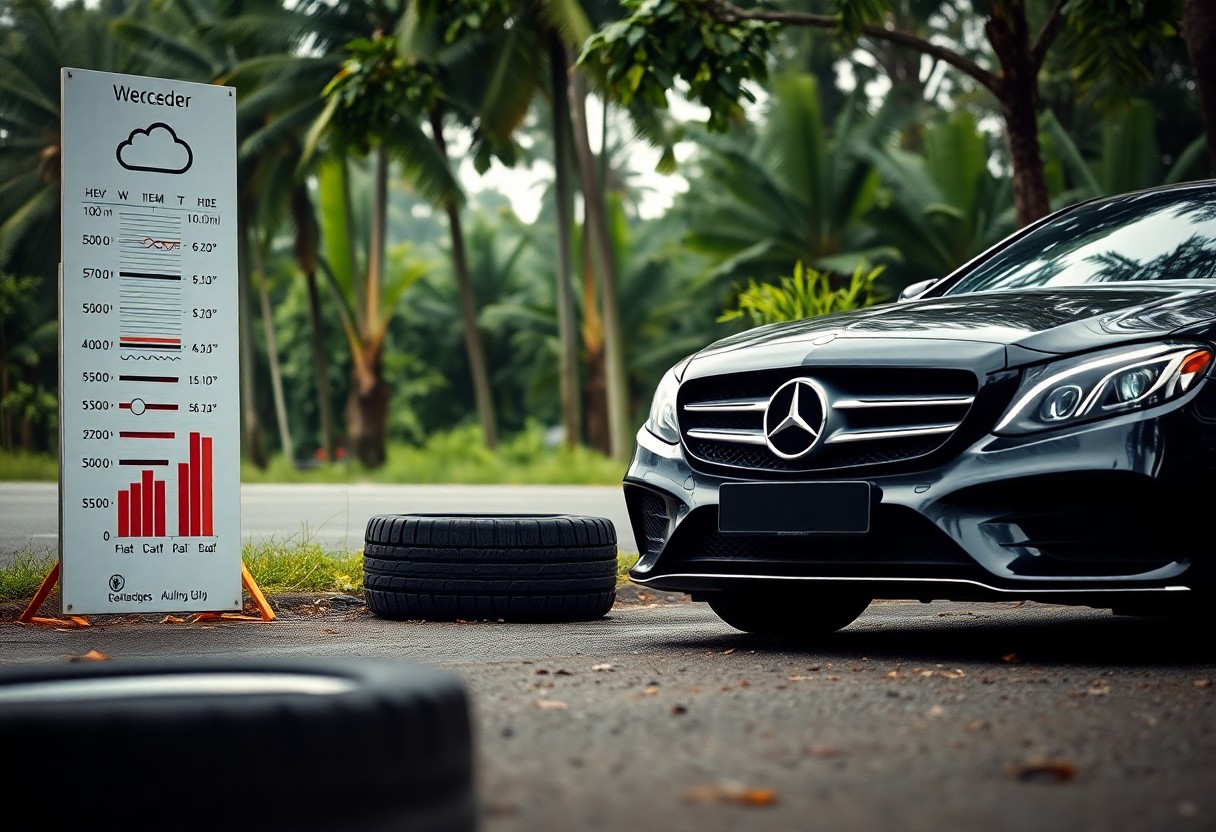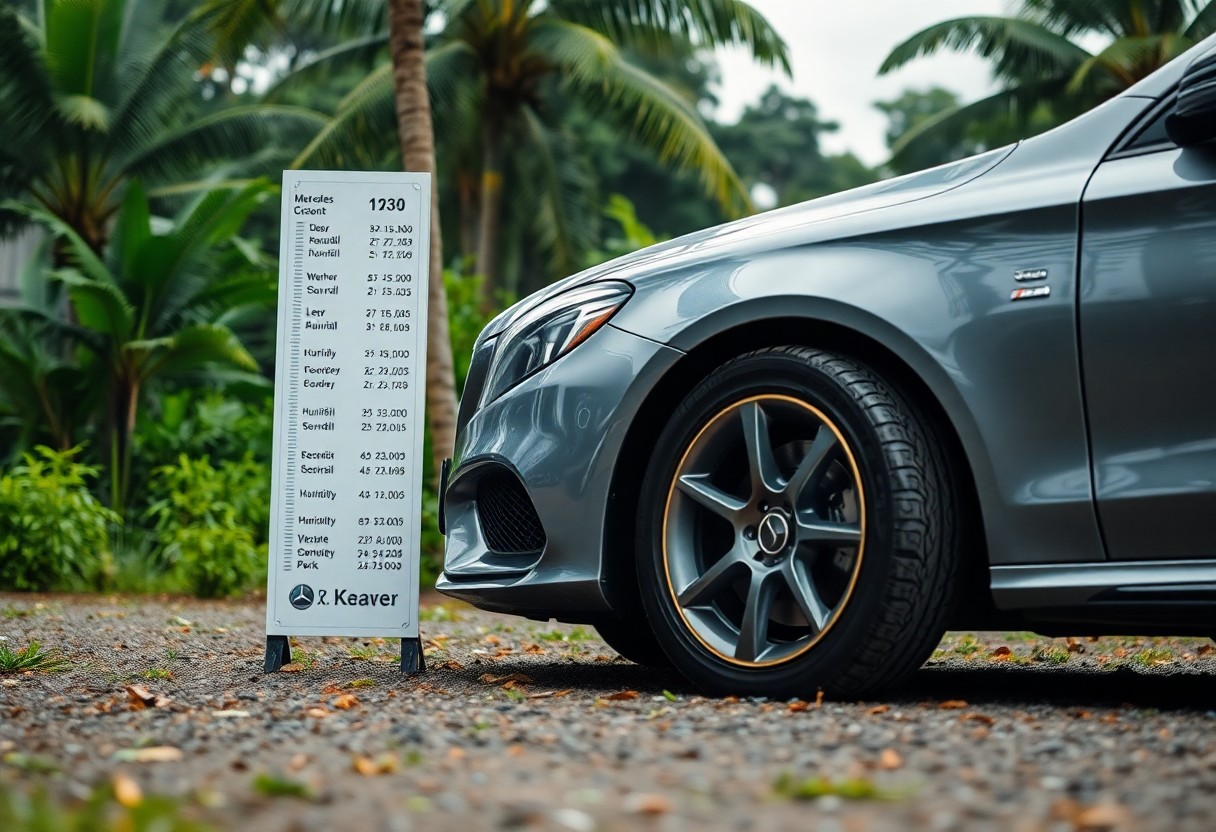There’s a vital aspect of vehicle maintenance that can significantly impact your safety and performance on the road – tyre replacement. In Klang’s unpredictable weather, knowing when to change your tyres is vital to ensuring maximum grip and control during wet and dry conditions. Pay attention to tread wear, changes in handling, and the specific seasonal challenges your Mercedes-Benz may face, as these can all indicate when it’s time for a tyre upgrade. Prioritizing your tyres can help you maintain optimal performance and safety for your luxury vehicle.
Key Takeaways:
- Monitor tread depth; tyres should be replaced when tread wears down to 1.6mm, especially for rainy conditions in Klang.
- Temperature variations in Klang can affect tyre pressure; check and adjust pressure monthly to optimize performance.
- Be aware of the 5-year rule; consider changing tyres that have been in use for more than five years regardless of tread wear.
- Consider the effects of humidity and rain; softer rubber compounds may wear faster in Klang’s tropical climate.
- Look for visible signs of damage, such as cracks or bulges, which indicate that tyres may need replacing sooner regardless of tread depth.
- Regularly inspect tyres for uneven wear, which can signal alignment or suspension issues that may necessitate early replacement.
- Stay informed on local weather forecasts; heavy rain seasons may require more frequent tyre assessments for optimal safety.
The Impact of Klang’s Climate on Tyre Durability
Klang’s tropical climate greatly influences tyre performance and lifespan. With high humidity levels and seasonal temperature variations, your tyres undergo constant stress that can accelerate wear. Understanding these elements is imperative for maintaining the optimal condition of your tyres. The area’s weather conditions can result in uneven wear patterns and premature ageing, making awareness of these impacts necessary for Mercedes-Benz owners.
Humidity and its Effects on Tyre Lifespan
High humidity levels in Klang can lead to increased moisture accumulation in tyre rubber, which may cause degradation. Exposure to water and steam can result in the growth of mould and fungus, further compromising the structural integrity over time. Regular inspections for signs of wear or damage become imperative for prolonging the lifespan of your tyres in such an environment.
Seasonal Temperature Fluctuations
Klang experiences significant temperature variations throughout the year, impacting your tyres in several ways. During hotter months, tyres can heat up beyond recommended levels, leading to accelerated tread wear. In cooler periods, tyres may harden, losing grip and traction, which can compromise safety. Monitoring these temperature shifts is imperative for optimal tyre performance.
Temperature Fluctuation Effects
| Temperature Range | Tyre Effect |
|---|---|
| Above 30°C | Increased wear and potential for blowouts |
| Below 20°C | Reduced flexibility and traction |
Whenever temperatures exceed 30°C, your tyres are at risk of overheating. This can lead to not just faster tread wear but also increases the likelihood of blowouts. On the other hand, when temperatures drop below 20°C, the rubber compounds harden, drastically reducing grip. Regular monitoring during temperature fluctuations can help you make timely adjustments, ensuring safety and extending the lifespan of your tyres.

Identifying Tyre Wear: Signs You Can’t Ignore
To maintain optimal safety and performance, recognizing signs of tyre wear is imperative. You should regularly check for any irregularities that could indicate it’s time to replace your tyres. Be aware of signs such as uneven wear, sidewall bulges, or cracks that can compromise your driving experience. If your tyres look worn out or don’t perform as expected, heed these warnings before hitting the road.
Tread Depth: What Every Owner Should Measure
Tread depth plays a vital role in your vehicle’s traction, especially in wet conditions. You should use a tread depth gauge or even a simple coin test to measure it regularly. A minimum tread depth of 1.6mm is required for legal road use, but for enhanced safety, consider replacing tyres once they reach 3mm in wet environments like Klang.
Visual and Physical Indicators of Deterioration
Keep an eye out for visual signs of tyre deterioration such as cracks, bubbles, or significant wear patterns. Any cuts or punctures on the sidewall can indicate a serious issue that could lead to blowouts. Additionally, the surface of the tyres should be free from obstructions or foreign materials that might impair performance.
Pay attention to physical indicators like vibration while driving, which might suggest misalignment or internal damage. Regular inspections should involve checking for bulges or deformities on the tyre surface, revealing potential trouble spots. Also, listen for unusual noises—these may be early signs of excessive wear or damage. Proactively addressing these problems can avert costly incidents and ensure safer driving conditions.

The Timing Game: When to Replace Your Tyres
Timing your tyre replacement in Klang requires more than just monitoring tread depth. Regular assessments of your tyres based on both mileage and visual checks, alongside performance indicators, play a pivotal role. You’ve likely heard the general rule of changing tyres every 5 to 6 years; however, in Klang’s challenging conditions, adjusting that timeframe may be necessary to ensure safety and performance.
Manufacturer Recommendations vs. Local Conditions
Follow your vehicle manufacturer’s recommendations for tyre replacement, as they consider design and usage factors. Yet, in Klang’s humid environment with frequent rain, you might need to shorten that timeframe. Additionally, the wear rate can vary if you often drive on rough or bumpy roads, necessitating a proactive approach in monitoring your tyres beyond the suggested intervals.
The Role of Driving Habits in Tyre Replacement
Your driving habits significantly influence how quickly your tyres wear down. Aggressive driving, frequent sharp turns, and rapid acceleration can lead to faster deterioration, rendering tyres unsafe sooner than expected. Conversely, smooth driving and proper tyre maintenance may extend their lifespan.
For example, if you regularly speed or tend to brake hard, you’re likely looking at a much shorter tyre lifespan than the average driver. Tyres subjected to harsh conditions face increased tread wear, degrading performance during rainy days—a common occurrence in Klang. It’s wise to keep a close eye on your tyre’s tread depth and overall condition, adjusting your replacement schedule according to your driving patterns to maintain optimal safety on the roads.
Choosing the Right Tyres for Klang’s Unique Weather
Selecting the appropriate tyres for Klang’s unique weather is fundamental for ensuring safety and performance. Given the frequent rain and high humidity, tyres that offer excellent wet traction and stability should be prioritized. All-weather tyres can be a suitable option, providing flexibility across various weather conditions while still meeting the demands of the winding roads and occasional heavy downpours typical in Klang.
All-Season vs. Specialty Tyres: A Critical Comparison
| Tyre Type | Benefits |
|---|---|
| All-Season | Versatile performance in wet and dry conditions; decent tread life. |
| Specialty | Designed for specific conditions (e.g., wet grip); enhanced performance. |
The Importance of Professional Recommendations
Seeking advice from tyre professionals ensures you choose a tyre that aligns with Klang’s specific conditions. Experts understand the nuances of various tyre models and how they interact with local climate challenges. For instance, they may recommend certain types of tread patterns that offer improved grip or temperature resistance, crucial for enhancing your driving safety and comfort in unpredictable weather.
Professional recommendations can greatly shape your decision-making process. They take into account your driving habits, vehicle type, and the local weather dynamics, helping you navigate through the plethora of options available. This personalized advice can reveal features of tyres like noise reduction, enhanced braking performance, and improved fuel efficiency that may not be apparent when browsing online. Trusting an expert helps to ensure that you invest in tyres that not only enhance your driving experience but also significantly boost your vehicle’s safety in Klang’s unpredictable climate.

Maintenance Tips for Prolonging Tyre Life
Enhancing the lifespan of your tyres isn’t just about choosing the right ones; it involves consistent maintenance. Here are some effective practices you can adopt:
- Regular inspections to identify any damage or wear
- Rotations every 5,000 to 8,000 kilometers
- Proper inflation checks monthly
- Wheel alignment services when necessary
Recognizing the significance of these measures can greatly extend the lifespan of your tyres.
Regular Inspections and Rotations
Scheduling regular tyre inspections is necessary for spotting potential issues before they escalate. Rotating your tyres at established intervals promotes even wear, ultimately enhancing traction and safety. Engaging a professional service will ensure your tyres remain in optimal condition while prolonging their usability.
Proper Inflation and Alignment Practices
Maintaining proper tyre inflation is vital; under-inflated tyres can lead to increased rolling resistance and heat, ultimately causing premature wear. Regularly check your tyre pressures—refer to the specifications in your vehicle’s manual. Moreover, ensuring your wheels are correctly aligned prevents uneven wear and improves driving stability, enhancing your overall driving experience in Klang’s challenging conditions.
Tyres operate best when inflated to the manufacturer’s recommended levels, which you can typically find on the driver’s side door jamb or in the owner’s manual. Keeping your tyres properly inflated can enhance fuel efficiency by up to 3% and reduces the risk of blowouts. Furthermore, misalignment can cause your vehicle to pull one way or the other, which might not only wear out your tyres faster but also compromise your safety on the roads. Regular checks every few months or following significant impacts, like hitting a pothole, can help maintain the integrity of your tyres.
Final Words
Conclusively, as a Mercedes-Benz owner in Klang’s climate, you should regularly inspect your tyres for wear and age, ideally every six months. Due to the region’s tropical weather, replacing your tyres every 40,000 to 50,000 kilometers is advisable, or sooner if tread depth becomes inadequate. Keeping an eye on weather patterns will also aid in timing, as wet conditions can necessitate earlier changes. Prioritize your safety and vehicle performance by being proactive with your tyre maintenance.
FAQ
Q: When is the best time to check my tyres for wear and tear in Klang?
A: It’s advisable to check your tyres at least once a month, especially during the wet and dry seasons in Klang. Look for signs of wear, such as uneven tread depth or cracks. Pay special attention before and after the monsoon season when road conditions can change rapidly.
Q: How often should I replace my tyres in Kuala Lumpur’s climate?
A: In Klang, if you maintain your tyres well, they should last around 5 to 6 years, depending on usage. However, you should consider replacing them sooner if you notice significant wear or damage. Regular inspections can help you make informed decisions about their lifespan.
Q: What signs indicate that I need to change my tyres?
A: Key indicators include uneven tread wear, visible cracks or bulges, reduced traction, and frequent loss of air pressure. If your tyres have less than 3mm of tread depth, it’s advisable to change them, especially considering Klang’s wet weather conditions where grip is crucial.
Q: Should I change all four tyres at once or just the worn ones?
A: Ideally, it’s best to replace all four tyres at once to maintain balanced handling and stability. If that’s not feasible, you should at least replace the two tyres that are most worn. When replacing fewer tyres, it’s recommended to put the new tyres on the rear axle to improve traction on wet surfaces.
Q: How does Klang’s weather affect tyre performance?
A: The high humidity and frequent rain in Klang can lead to reduced grip and increased wear on your tyres. Wet conditions can hydroplane if treads are worn. During hot weather, tyres may also degrade quicker due to heat exposure. Hence, regular checks are important to ensure your tyres adapt well to these varying conditions.
Q: Is it necessary to rotate my tyres even in Klang’s climate?
A: Yes, rotating your tyres is recommended to ensure even wear. In Klang’s weather, varying driving conditions can cause uneven tread wear. Regular rotation helps prolong your tyre life and enhances driving stability and safety.
Q: What type of tyres perform best in Klang’s diverse weather conditions?
A: All-season tyres are generally suitable for Klang’s climate, as they provide adequate performance in both wet and dry conditions. However, if you encounter heavy rainfall frequently, you might consider investing in tyres specifically designed for wet conditions, which offer better traction and handling.
